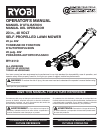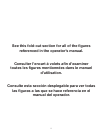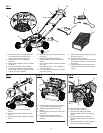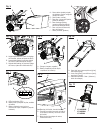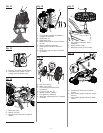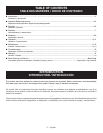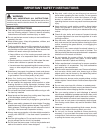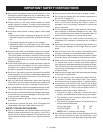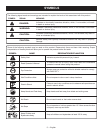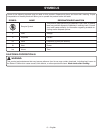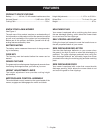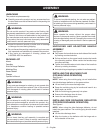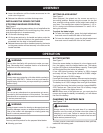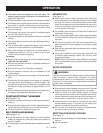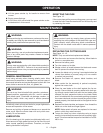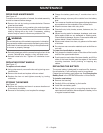
4 — English
IMPORTANT SAFETY INSTRUCTIONS
Never direct discharged material toward anyone. Avoid
discharging material against a wall or obstruction. Ma-
terial may ricochet back toward the operator. Stop the
blade when crossing gravel surfaces.
Objects struck by the lawn mower blade can cause
severe injuries to persons. The lawn should always be
carefullyexaminedandclearedofallobjectspriortoeach
mowing.
If the lawn mower strikes a foreign object, follow these
steps:
•
Stop the lawn mower by releasing the upper bail, wait until
the blade comes to a complete stop, and then remove fuse
key.
• Thoroughlyinspectthemowerforanydamage.
• Replacethebladeifitisdamagedinanyway.Repair
any damage before restarting and continuing to operate
the mower.
Stop the motor, wait until the blade comes to a complete
stop, and remove fuse key before unclogging the chute.
The cutting blade continues to rotate for a few seconds
after the motor is shut off. Never place any part of the
body in the blade area until you are sure the blade has
stopped rotating.
If the mower should start to vibrate abnormally, stop the
motor and check immediately for the cause. Replace
the blade if it is unevenly worn or damaged in any way.
Vibration is generally a warning of trouble.
Service on the product must be performed by qualified
repair personnel only. Service or maintenance performed
by unqualified personnel could result in injury to the user
or damage to the product.
Use only authorized replacement parts when servicing
the product. Use of unauthorized parts may create a risk
of serious injury to the user, or damage to the product.
Do not place battery tools or their batteries near fire or heat.
Thiswillreducetheriskofexplosionandpossiblyinjury.
Do not open or mutilate battery (ies). Released electrolyte
is corrosive and may cause damage to the eyes or skin.
Itmaybetoxicifswallowed.
If electrolyte contacts the skin, wash it off immediately
with water.
If electrolyte contacts the eyes, flush thoroughly and
immediately with water. Seek medical attention.
SAFETY RULES FOR CHARGER
Use of an attachment not recommended or sold by the
battery charger manufacturer may result in a risk of fire,
electric shock, or injury to persons. Following this rule will
reduce the risk of electric shock, fire, or serious personal
injury.
Do not service mower with fuse key or charger installed.
Do not use the charger when the ambient temperature is
above
40°C
or below
0°C
.
Do not operate charger with a damaged cord or plug,
which could cause shorting and electric shock. If
damaged, have the charger replaced by authorized
service personnel.
Do not operate charger if it has received a sharp blow,
been dropped, or otherwise damaged in any way. Take
it to an authorized service center for electrical check to
determine if the charger is in good working order.
Unplug charger from outlet before attempting any
maintenance or cleaning to reduce the risk of electric
shock.
Disconnect charger from the power supply when not in
use to prevent damage to the charger during a power
surge.
Risk of electric shock. Do not touch uninsulated portion
of output connector or uninsulated battery terminal.
Donotexposechargertowetordampconditions. Water
entering charger will increase the risk of electric shock.
Make sure cord is located so that it will not be stepped
on, tripped over, come in contact with sharp edges or
moving parts or otherwise subjected to damage or stress.
This will reduce the risk of accidental falls, which could
cause injury, and damage to the cord, which could result
in electric shock.
Keep cord and charger away from heat to prevent damage
to housing or internal parts.
Do not let gasoline, oils, petroleum-based products,
etc. come in contact with plastic parts. They contain
chemicals that can damage, weaken, or destroy plastic.
Anextensioncordshouldnotbeusedforthecharger
unlessabsolutelynecessary.Useofimproperextension
cord could result in a risk of fire and electric shock. If
extensioncordmustbeused,makesure:
a.Thatpinson plugofextensioncord arethesame
number, size and shape as those of plug on charger.
b.Thatextension cordisproperly wiredandin good
electrical condition; and
c. That wire size is large enough for AC ampere rating of
charger as specified below:
Cord Length (Feet) 25' 50' 100'
Cord Size (AWG) 16 16 16
NOTE: AWG = American Wire Gauge
Save these instructions. Refer to them frequently and use
them to instruct others who may use this product. If you
loan someone this tool, loan them these instructions also.



